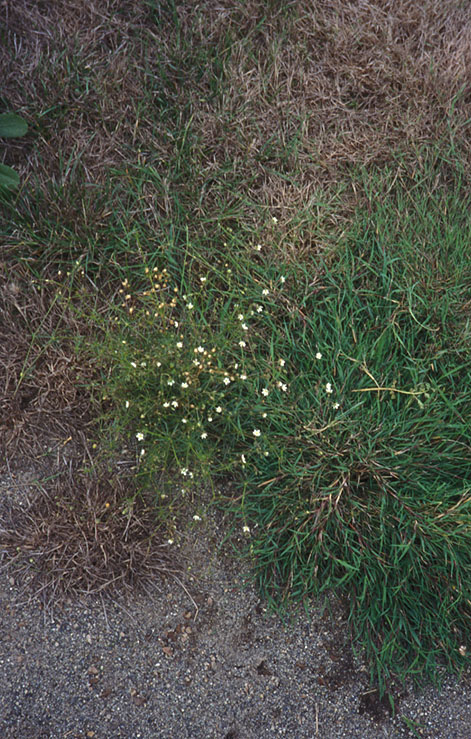
|
| Corn Spurry; Spergula arvensis L. |
Pink Family; CARYOPHYLLACEÆ
|
| Corn Spurry (sometimes spelled Spurrey) has two roles. One role is as a friend to humankind, the other quite contrary. Guess
which manifestation is most common in our area? As luck would have it, Seattle's Corn Spurry population seems to be the weedy version. |
| Compared to many weeds, Corn Spurry is a runt, seeming more like a weak, "floristically disadvantaged" wildflower than
a REAL WEED. At any rate, such is its usual mien in our area. |
| In its native Europe and indeed likely elsewhere it can be a serious pest, or a benefactor. Its name refers to it being the Spurry
that is common in cornfields. Corn, in this sense, is not the New World "Maize" or "Indian Corn," but rather the grain we call wheat.
In other words, the name Corn Spurry means, in modern U.S. lingo, "Wheatfield Spurry." Spurry itself is a name derived from the
Latin spargo/ spargere, meaning to scatter: from the sowing of the seeds to produce quick-growing early forage. |
| Other old English names for it are: Pine Cheat (its seedlings look like little pines), Devil's Gut (it is so stringy and sticky),
Pick Purse (its seedpods), Farmer's Ruin (an exaggeration), Starwort (from its flowers), Cow Quake (I have no idea why), and Yarr
(also unknown). But plain old Spurry is the prevalent name, with counterparts such as the French Spergoute, German Spörgel,
Dutch Spurrie, Danish Spergel, Italian Spergola,
etc. |
| This little weed is an annual, in some ways like its cousin Chickweed
(Stellaria media; Weed-of-the-month February 1986), in being a tangled thing of sprawling slender-stems, bearing pea-sized white flowers. It is very hardy and can be found practically
year-round. It is usually seen with its delightful flowers between March and October. Its stems are minutely hairy-sticky, like its
leaves, which are skinny as wire, and arranged 6 to 10 (13) per whorl. It grows a foot or two tall and wide. In especially poor sites it
stays much dwarfer. |
| In Seattle, Corn Spurry has been wild for more than 100 years, growing in tree wells cut in sidewalks, and in some
gardens, flower-beds and fields. It is not conspicuous, except in bloom --and then only to the sensitive eye. Though tolerating barren,
hard-packed waste ground and sterile beaches, it thrives in rich, disturbed soil, and in any case prefers full sunshine. |
| Besides being a pest, it has its other side. A race of it has been employed as a fodder for cattle and sheep, and is liked by
poultry. It can be grown as a fair grondcover/green manure on poor, sandy soil. The seeds are edible and have been used to make bread.
The greens have been cooked as a vegetable. I tasted it raw and decided to not bother with further culinary adventures. |
In short, Corn Spurry instills no terror, and causes no great anguish to us. It is a minor curiosity of a pest, with some bona
fide, albeit trivial uses.
|
Originally published as the Seattle Tilth newsletter Weed of the Month in March 1994, along with an illustration from a book.
Back |
|
|

